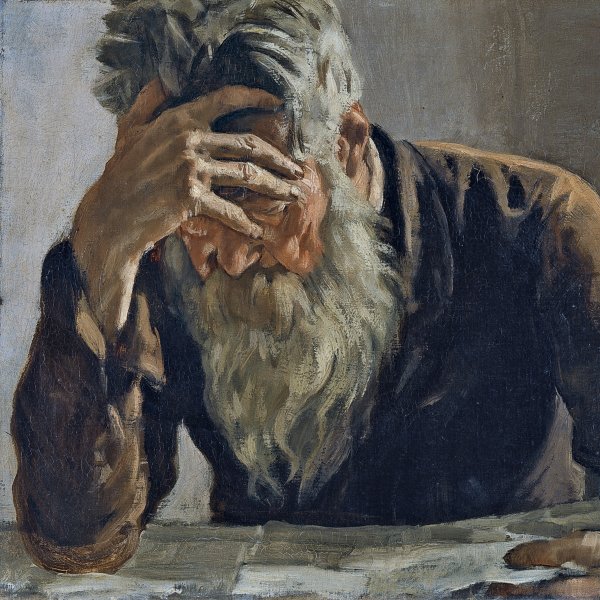The Voices
ca. 1880
Watercolor and gouache on Paper.
22 x 12 cm
Museo Nacional Thyssen-Bornemisza, Madrid
Inv. no.
684
(1976.67
)
Not exhibited
Level 2
Permanent Collection
Level 1
Permanent Collection
Level 0
Carmen Thyssen Collection and Temporary exhibition rooms
Level -1
Temporary exhibition rooms, Conference room and EducaThyssen workshop
The Voices, a small, delicate work on paper, is a paradigmatic example of the Symbolist style of the French painter Gustave Moreau. The scene is related to the theme of Hesiod and the Muses, one of the motifs of which the painter produced the most versions. The young Hesiod, the main figure in the composition, is attired in a hooded tunic with a shepherd’s crook, which recall his youthful years when he lived as a peasant, tending a flock of sheep. He is depicted in half profile with a pensive air, listening to the inspiration of the muse who hands him a laurel wreath. According to the account by the Greek poet, the daughters of the god Zeus “one day taught Hesiod glorious song while he was shepherding his lambs under holy Helicon” and “gave me a rod, a shoot of sturdy laurel, a marvellous thing, and breathed into me a divine voice to celebrate things that shall be and things there were aforetime; and they bade me sing of the race of the blessed gods that are eternally, but ever to sing of themselves both first and last.”
According to Hans Hofstätter, the temple in the distance, a rendering of the Parthenon, is related to the facade of the temple depicted in Ingres’s Apotheosis of Homer. Furthermore, the Orientalist preciosity of Moreau’s style, stemming from his years at Chassérieu’s workshop, is heightened in this work by the decorative tortoiseshell frame designed by the artist himself. The first owner of The Voices, the collector Edmond Taigny, auditor of the Council of State and a very active member of the Union Centrale des Arts Décoratives, commissioned a reproduction in enamel from Grandhomme et Garnier, which was shown in the Paris Exposition Universelle of 1889 and acquired by the Musée des Arts Décoratives in Paris.
Although Pierre-Louis Mathieu, one of the authorities on the painter’s oeuvre, dated the watercolour to around 1867 owing to its resemblance to the October 1867 version, G. Lacambre more recently considered it definitely to have been executed around 1880, shortly before being sold to Taigny, as the style of the work matches that of others from that period. Nowadays the richly textured, colourist and excessive oeuvre of Moreau, the master of artists like Matisse, Rouault and Marquet and vindicated years later by the Surrealists, is considered a bridge between tradition and modernity. In his commentary on this work, Bozal precisely pointed out that “whereas on the one hand the sense of narration and myth that are characteristic of this work look to the past, to Romanticism even, on the other the formal handling reveals an originality that shows the beginnings of modernity.”
Paloma Alarcó
According to Hans Hofstätter, the temple in the distance, a rendering of the Parthenon, is related to the facade of the temple depicted in Ingres’s Apotheosis of Homer. Furthermore, the Orientalist preciosity of Moreau’s style, stemming from his years at Chassérieu’s workshop, is heightened in this work by the decorative tortoiseshell frame designed by the artist himself. The first owner of The Voices, the collector Edmond Taigny, auditor of the Council of State and a very active member of the Union Centrale des Arts Décoratives, commissioned a reproduction in enamel from Grandhomme et Garnier, which was shown in the Paris Exposition Universelle of 1889 and acquired by the Musée des Arts Décoratives in Paris.
Although Pierre-Louis Mathieu, one of the authorities on the painter’s oeuvre, dated the watercolour to around 1867 owing to its resemblance to the October 1867 version, G. Lacambre more recently considered it definitely to have been executed around 1880, shortly before being sold to Taigny, as the style of the work matches that of others from that period. Nowadays the richly textured, colourist and excessive oeuvre of Moreau, the master of artists like Matisse, Rouault and Marquet and vindicated years later by the Surrealists, is considered a bridge between tradition and modernity. In his commentary on this work, Bozal precisely pointed out that “whereas on the one hand the sense of narration and myth that are characteristic of this work look to the past, to Romanticism even, on the other the formal handling reveals an originality that shows the beginnings of modernity.”
Paloma Alarcó








